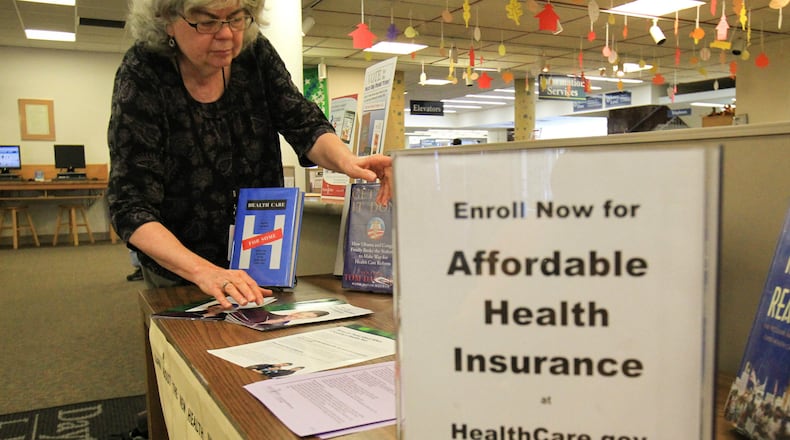County Civilian population Uninsured % Uninsured
Darke 52,274 6,598 12.6%
Montgomery 526,516 64,051 12.2%
Clark 136,257 16,279 11.9%
Preble 41,868 4,898 11.7%
Champaign 39,527 4,263 10.8%
Butler 364,934 39,164 10.7%
Miami 101,582 10,839 10.7%
Warren 207,706 15,410 7.4%
Dayton region 1,470,664 161,502 11.0%
Ohio 11,356,139 1,318,597 11.6%
Source: U.S. Census Bureau’s American Community Survey
Note: Because of margins of error, apparent differences may not be significant at the 90% confidence interval.
More online: We break down health insurance rates by county on our interactive page at MyDaytonDailyNews.com/local.
Living without health insurance isn’t just a big city problem in Ohio.
While Ohio’s metropolitan counties have the highest raw numbers of uninsured, the 20 Ohio counties with the highest rates of uninsured are all rural in nature.
And 15 of Ohio’s top 20 uninsured counties are officially designated as Appalachian by the Appalachian Regional Commission.
In addition, counties with high rates of uninsured are significantly more likely to have lower median household incomes, a Dayton Daily News analysis found.
The new estimates, released Tuesday, are from the American Community Survey’s five-year data covering the period from 2008 through 2012.
Rana Peake, Appalachian Outreach Coordinator at Sinclair Community College, said there is a strong correlation between the percentage of poor residents and those without health insurance.
“If there’s a lack of industry or a lack of jobs, you’re going to see the higher rates of poverty, the higher rates of unemployment, and thus, naturally, higher rates of uninsured,” Peake said.
Part of the problem for residents in rural areas — and especially in Appalachian areas — is isolation, Peake said.
“There’s the assumption that it’s easy for people to have access to computers,” Peake said when asked whether those in Appalachia are signing up online for the Affordable Care Act. “There’s an assumption that it’s easy for people to have access to transportation to get to someplace to have a computer.”
That’s not always true in rural areas, Peake said.
“In an urban community you have access to public transportation that can help you get to places that you might need to be,” she said. “It’s still challenging for many people, but in a rural setting that challenge increases.”
The lack of health insurance is only one problem people living in Appalachia face when dealing with health issues, said Philip Obermiller, a sociologist and research fellow at the Appalachian Center at the University of Kentucky.
Residents in Appalachian communities have significantly higher incidences of cancer, heart disease, diabetes, kidney disease and other problems, said Obermiller, who is co-editor of “Appalachian Health and Well-Being,” a compilation of articles about health issues in the multi-state region.
People living in rural areas are also farther away from emergency rooms and doctors, he said.
“Appalachia has some of the most rural counties in the country,” Obermiller said. “There are hospitals and clinics in the region, but can you get to them, even if you have a health card? How far away are they?”
Still, Obermiller said, having health insurance is an important tool for dealing with the problem of access to health care.
“Perhaps with more people with insurance, that will increase the services that are made available and therefore decrease the problems with accessibility,” he said.
The county with the highest rate of uninsured residents during the the five-year period is Holmes County in the heart of Amish country. In Holmes and some surrounding counties, many residents have historically chosen not to participate in commercial or government-sponsored health insurance.
Holmes County has almost 19,000 uninsured residents in a county of 42,000 people, meaning 45 percent of its residents do not have traditional health insurance.
The next highest county — Adams — had a rate of about 18 percent.
While both Holmes and Adams counties are designated as Appalachian, the difference in Holmes County is religion.
Holmes County, in rolling farm country northeast of Columbus, has the second-largest population of Amish in any county in the nation, according to the 2010 U.S. Religion Census. That survey, conducted by the Association of Statisticians of American Religious Bodies, found that Holmes County had almost 18,000 Amish adherents, second only to Lancaster County, Pa.
The Amish traditionally shun any sort of commercial or government health insurance, said Dr. D.J. McFadden, commissioner of the county’s health district.
“They have things we would call mutual aid funds or brotherhood funds or fellowship funds,” McFadden said. “With some of the need, collections are taken, and there are funds that churches collect money for. But most people would not consider that insurance.”
McFadden said a provision in the health care law exempts the Amish from the mandate requiring most Americans to buy health insurance.
About the Author
